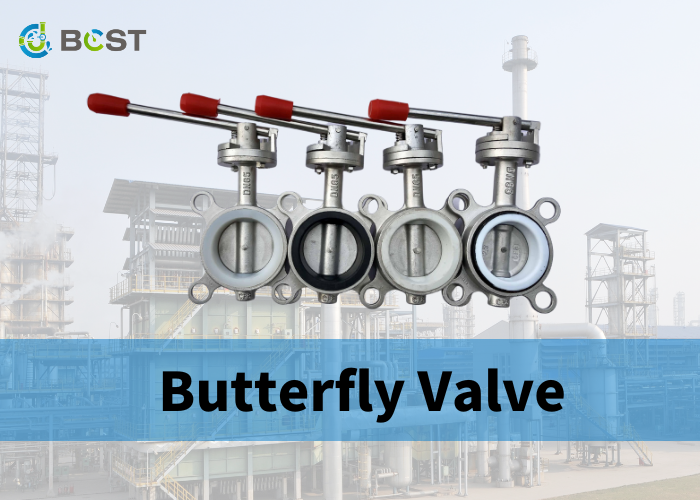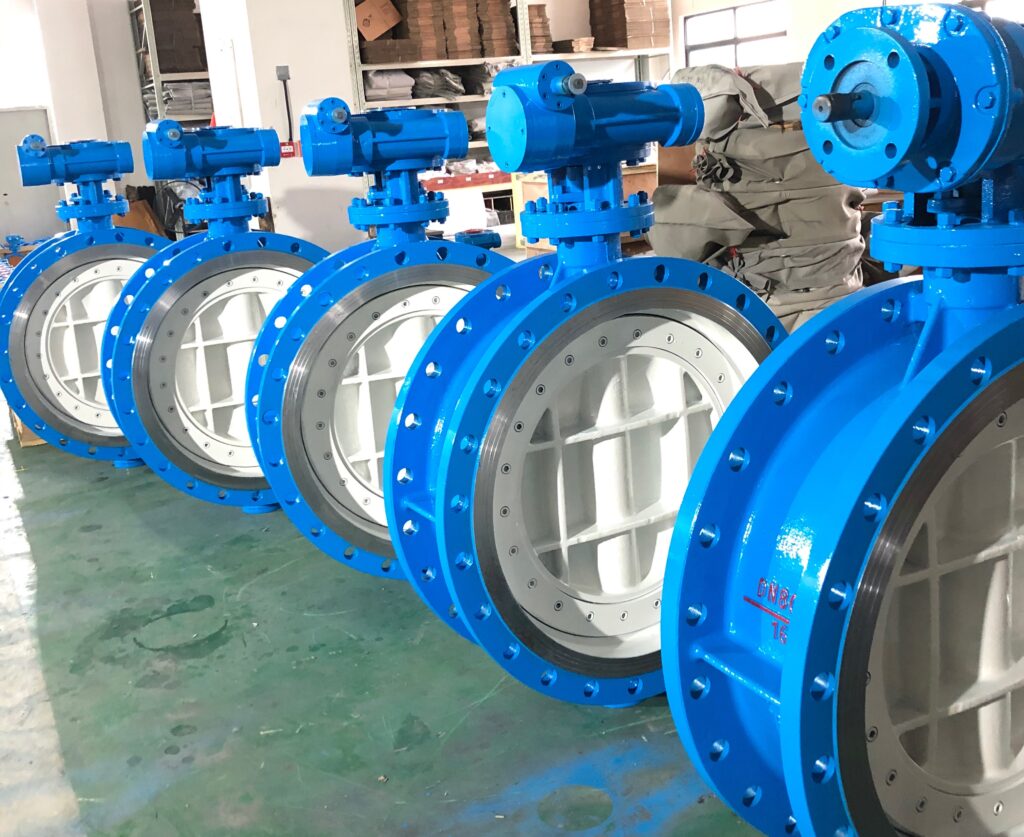
A butterfly valve, also known as a flap valve, is a regulating valve with a simple structure that can be used for switching and regulating low-pressure pipeline media. It is defined by having a closing component (valve disc or butterfly plate) shaped like a round disc that rotates around the valve shaft to achieve opening and closing.
There are many types of butterfly valves, which can be divided into many types according to different classification methods. In this article, we will introduce them based on seven aspects: driving mode, structural form, sealing surface material, working pressure, working temperature, sealing form, and connection method.
1. Driving Mode:
In terms of driving method, butterfly valves can be divided into electric butterfly valves, pneumatic butterfly valves, hydraulic butterfly valves, and manual butterfly valves.
(1) Electric Butterfly Valve:
An electric butterfly valve is a self-control valve driven by an electric actuator. It allows for remote control, saves manual labor, and is widely used in automation as the industry develops.
(2) Pneumatic Butterfly Valve:
Pneumatic butterfly valves are powered by compressed air and have the characteristics of energy conservation, environmental protection, and fast opening and closing. With additional components like solenoid valves and positioners, they can be used for automatic control and regulating valves. Pneumatic butterfly valves are increasingly used in low-pressure, large-diameter and medium-diameter pipelines.
(3) Hydraulic Butterfly Valve:
Hydraulic butterfly valves are mainly used as emergency shut-off valves in high safety systems such as steam turbine extraction pipelines, TRT (Turbine Rotor Test) devices for blast furnace gas, and industrial pipelines with media such as seawater, wastewater, flue gas, air, and various oils. These valves are widely employed in the metallurgical industry to prevent blast furnace gas backflow and in the power industry to prevent steam from entering the turbine during load shedding, protecting the turbine and generator.
(4) Manual Butterfly Valve:
Manual butterfly valves are simple and lightweight to operate, but they are not suitable for valves with large diameters and requirement for frequent opening and closing.
2. Structural Type:
In terms of structure type, butterfly valves can be divided into concentric butterfly valves, single eccentric sealing butterfly valves, double eccentric sealing butterfly valves, and triple eccentric butterfly valves.
(1) Concentric Butterfly Valve:
A concentric butterfly valve has its stem axis, butterfly plate center, and body center aligned. It’s simple to manufacture but not very resistant to wear or high temperatures. As the butterfly plate and valve seat are always in a squeezing and scraping state, there is a large resistance distance and fast wear.
(2) Single Eccentric Sealing Butterfly Valve:
To address the issue of squeezing between the butterfly plate and the seat in concentric butterfly valves, single eccentric sealing butterfly valves were developed. The advantage of the single eccentric butterfly valve is that the rod axis deviates from the center of the butterfly plate, so that the upper and lower ends of the butterfly plate no longer become the rotating axis, dispersing and reducing excessive compression between the upper and lower ends of the butterfly plate and the valve seat. However, single eccentric butterfly valves also have their drawbacks. Due to the fact that the single eccentric structure only reduces the scratch phenomenon between the butterfly plate and the valve seat to a certain extent during the entire opening and closing process of the valve, it is similar to concentric butterfly valves in terms of application range, so it is not widely used.
(3) Double Eccentric Sealing Butterfly Valve:
On the basis of the single eccentric butterfly valve, the widely used double eccentric butterfly valve is further improved and formed.Its structure is characterized by the stem axis deviating from the center of the butterfly plate and the center of the valve body. Their double eccentricity allows the butterfly plate to quickly detach from the valve seat after the valve is opened, greatly eliminating unnecessary excessive pressure and friction between the butterfly plate and the valve seat, reducing the opening resistance, reducing wear, and extending the service life of the valve seat. The significant reduction in scraping also enables the use of metal seats for double eccentric butterfly valves, improving their application in high-temperature fields. However, due to its sealing principle being a positional sealing structure, where the sealing surface between the butterfly plate and the valve seat is in line contact, the elastic deformation caused by the compression of the valve seat by the butterfly plate produces a sealing effect. Therefore, high requirements are placed on the closed position (especially the metal valve seat), and the pressure bearing capacity is low. This is why traditional people believe that butterfly valves are not resistant to high pressure and have a large leakage amount.
(4) Triple Eccentric Butterfly Valve:
To be high temperature resistance, a hard seal must be used, but the leakage is large; To achieve zero leakage, a soft seal must be used, but it is not resistant to high temperature. To overcome the contradiction of double eccentric butterfly valves, a third eccentricity was performed on the butterfly valve, resulting in the creation of a triple eccentric butterfly valve. Its structural feature is that the valve plate has an elliptical cone shape. At the same time as the axis of the double eccentric valve stem is eccentric, the conical axis of the butterfly plate sealing surface is skewed towards the cylindrical axis of the body. That is to say, the sealing section of the triple eccentric butterfly plate is no longer circular, but elliptical. Its sealing surface shape is asymmetric, with one side inclined to the center line of the body and the other side parallel to the center line of the body. The most outstanding feature of the triple eccentricities is that they fundamentally change the sealing structure, no longer relying on positional sealing, but on torsional sealing, that is, not relying on the elastic deformation of the valve seat, but completely relying on the contact surface pressure of the valve seat to achieve the sealing effect.

1. Sealing Surface Material:
In terms of the sealing surface material, butterfly valves can be divided into soft sealing butterfly valves and metal hard sealing butterfly valves.
(1) Soft Sealing Butterfly Valve:
Soft sealing butterfly valves offer excellent sealing but are less resistant to wear, extreme temperatures, and corrosion. They are suitable for applications involving gas, clean water, sewage, seawater, and various oils within a temperature range of -10°C to 150°C.
(2) Metal Hard Sealing Butterfly Valve:
Metal hard sealing butterfly valves use metal materials for sealing, featuring a triple eccentric design for a tight seal. They are resistant to high temperatures and have a long service life, making them suitable for use with oil, gas, hot water, and other media within a temperature range of -10°C to 425°C, commonly used in industries like petroleum, petrochemicals, chemicals, metallurgy, and power generation.
2. Working Pressure:
In terms of working pressure, butterfly valves can be divided into vacuum butterfly valves, low-pressure butterfly valves, medium–pressure butterfly valves, high-pressure butterfly valves, and ultra-high–pressure butterfly valves.
(1) Vacuum Butterfly Valve:
A butterfly valve with a working pressure lower than standard atmosphere pressure.
(2) Low-Pressure Butterfly Valve:
A butterfly valve with the nominal pressure (PN) less than 1.6 MPa.
(3) Medium-Pressure Butterfly Valve:
A butterfly valve with the nominal pressure (PN) between 2.5 to 6.4 MPa.
(4) High-Pressure Butterfly Valve:
A butterfly valve with the nominal pressure (PN) between 10.0 to 80.0 MPa.
(5) Ultra-High-Pressure Butterfly Valve:
A butterfly valve with the nominal pressure (PN) exceeding 100 MPa.
3. Working Temperature:
In terms of working temperature, butterfly valves can be divided into high-temperature butterfly valves, medium-temperature butterfly valves, ordinary–temperature butterfly valves, low-temperature butterfly valves, and ultra-low-temperature butterfly valves.
(1) High-Temperature Butterfly Valve:
Suitable for temperatures exceeding 450°C.
(2) Medium-Temperature Butterfly Valve:
Suitable for temperatures between 120°C and 450°C.
(3) Ordinary-Temperature Butterfly Valve:
Suitable for temperatures between -40°C and 120°C.
(4) Low-Temperature Butterfly Valve:
Suitable for temperatures between -100°C and -40°C.
(5) Ultra-Low-Temperature Butterfly Valve:
Suitable for temperatures below -100°C.
4. Sealing Type:
In terms of sealing type, butterfly valves can be divided into forced sealing butterfly valves, pressure-loaded sealing butterfly valves, automatic sealing butterfly valves.
(1) Forced–Sealing Butterfly Valve:
Forced–sealing butterfly valves can be further categorized into elastomer-sealed butterfly valves and externally torque-sealed butterfly valves. Elastomer-sealed butterfly valves achieve sealing by having the valve disc press against the valve seat when the valve is closed, creating elasticity in either the seat or the disc. In contrast, externally torque-sealed butterfly valves generate sealing pressure through external torque applied to the valve shaft.
(2) Pressure-Loaded Sealing Butterfly Valve:
Pressure-loaded sealing butterfly valves establish sealing pressure by applying pressure to the sealing components on the valve seat or disc..
(3) Automatic Sealing Butterfly Valve:
Automatic sealing butterfly valves rely on medium pressure to automatically generate sealing pressure.
5. Connection Method:
In terms of connection method, butterfly valves can be divided into wafer-type butterfly valves, flanged butterfly valves, lug-type butterfly valves, and welded butterfly valves. Among them, wafer-type and flanged butterfly valves are the most common.
(1) Wafer Butterfly Valve:
Wafer-type butterfly valves are secured between two pipeline flanges using double-headed bolts. These valves feature a simple structure, small volume, light weight, and consist of only a few components. They can be rapidly opened or closed with just a 90° rotation, providing ease of operation. Furthermore, these valves exhibit excellent fluid control characteristics.
(2) Flanged Butterfly Valve:
Flanged butterfly valves have flanges on both sides of the valve, with matching flanges on the pipeline connected using bolts and nuts.
(3) Lug Butterfly Valve:
Lug-type butterfly valves have a unique three-way eccentric design that eliminates frictional contact between sealing surfaces, extending the valve’s lifespan. Elastic sealing is generated through torque. Their clever wedge design provides automatic sealing functionality, compensating for and eliminating leaks between sealing surfaces. And these valves are characterized by their small size, light weight, ease of operation, and convenient installation.
(4) Welded Butterfly Valve:
Welded butterfly valves are designed and manufactured with a new structural form that involves welding a central disc to short structural steel plates. They feature a compact structure, low weight, easy installation, minimal flow resistance, and convenient operation. Their internal design lacks connecting rods, bolts, etc., ensuring reliability and an extended service life. They can be installed in multiple positions and are unaffected by the flow direction of the medium.






